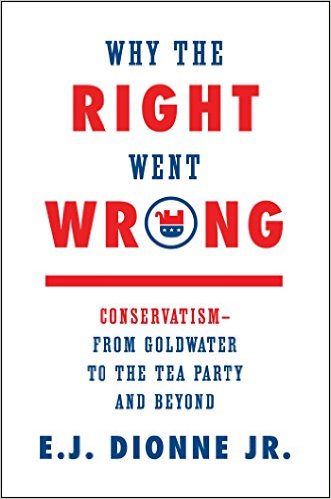How something so right had to go so wrong
 The last time Republicans won a presidential election it was 2004.
The last time Republicans won a presidential election it was 2004.
George W. Bush prevailed by trumpeting his ability to keep us safe, despite the 9/11 attacks and the failing wars in Iraq and Afghanistan, while his domestic agenda revolved around supporting “traditional marriage” and immigration reform. Deep in his campaign literature, you’d find he was also proposing privatizing Social Security, but it didn’t figure heavily in the campaign.
Today, twelve years later, thrice-married Donald Trump is the Republican frontrunner. His opposition to immigration reform, in general, and Mexico, Mexicans, and China, in specific, defines his campaign. He touts his opposition to the war in Iraq (after it started) and promises to preserve Social Security and Medicare (though his $11 trillion in proposed tax breaks would likely make that impossible).
How did conservatives end up with a candidate who is almost an exact negative image of its last winning standard-bearer?
Sure, the utter collapse of George W. Bush in his second term provides much of the answer. But E.J. Dionne’s new book Why the Right Went Wrong: Conservatism — From Goldwater to the Tea Party and Beyond makes the case that some sort of crackup on the right was inevitable — the culmination of decades of the rise of a movement that transformed American politics while failing to live up to its most fundamental promise to shrink government.
In many ways, Dionne argues, 2004 was the peak and the breaking point of the Goldwaterism Republicans first embraced in 1964.
The polarities of the party had completely switched, with Republicans sweeping the South and Democrats dominating the old GOP stronghold of New England. Even more remarkably, working class Americans who’d thrived under New Deal policies had completely embraced the right-wing ethos of gutting government in favor of an economy guided by the infallible wisdom of the market/your boss’ boss’ boss.
The GOP bought the message, but the messengers kept letting them down, Dionne explains:
Again and again, conservatives were promised that this election victory, and then the next, and then the next, would finally rout the statists and return the nation to the smaller government they were certain our Founders had in mind. And again and again, conservatives were disappointed. Neither Nixon nor Reagan nor either President Bush could fulfill a promise that, in truth, most Americans did not want kept.
After the victory of 2004 was followed by the resounding defeats of 2006 and 2008, the party abandoned many, if not all, of its pretensions to the middle and became the party Barry Goldwater conservatives had always hoped it would be. The robust infrastructure and savvy machinations of the big business-financed right-wing conspiracy had built a party that could dominate Congress and state legislatures but begins each presidential election with two guns pointed at its feet.
Dionne’s book is both piercing narrative and an artful warning about how how the inability of the right to evolve threatens our democracy. He traces far right’s climb from the siren’s call of Goldwater’s Conscience of a Conservative to dog-whistled appeals of Nixon and Reagan to the modern battle between “Reformicons” and the nativist/ authoritarian urges that are testing the bounds of the party.
The book ends by asking the crucial question of our time: What’s so conservative about a party of radicals who want to shred the advances of the last century?
The great reckoning long predicted for the Republican Party now seems more possible than ever, given the demographic walls that are being built around its ideology.
But Dionne also slips in a subtle warning for liberals.
The frustration that threatens the alliance of the conservative and libertarian strains who built the modern Republican ideology is finding its voice in a candidate who seems to be parody of a modern conservatism with his pretensions to piety layered over his bellicose, authoritarian lust to stomp on enemies.
Much has been made of the theory that “missing white votes” cost Mitt Romney the 2012 election. Ted Cruz seems to think the solution to finding them is running a candidacy that matches everything liberals hate about the right. But the theory’s author, Sean Trende, makes the case that the right needs to find new ways to win over white voters a traditional Republican could never avow.
Dionne quotes Trende, “The GOP would have to be more ‘America first’ on trade, immigration and foreign policy; less pro-Wall Street and big business in its rhetoric; more Main Street/populist on economics.”
And it would have to be all these things without losing evangelicals and the Chamber of Commerce backing that has made the modern GOP possible. And there’s a simple way to do that — pretend to love a Bible that you’ve obviously never read and promise massive tax breaks.
“When Donald Trump ran for president, he campaigned as if he had read Trende’s analysis,” Dionne writes.
While conservatism is a true religion for many, Trump is helping to reveal that Republicanism is a reluctant marriage of those who care about projecting their religious vision onto others, those who think tax cuts are a religion, and those who just want to dominate losers.
The question is are there are still enough white voters — and black voters who’d vote for a birther — to make it work.
You can see E.J. Dionne talk about Why the Right Went Wrong at the following dates:
2/24 Louisville/ Kentucky Author Forum – in conversation with James Fallows
2/25 Chicago/ Union League Club
2/25 Chicago/ Public Library
2/26 Madison/ Public Library – in conversation with Ruth Coniff of The Progressive
3/22 Minneapolis/ University of Minnesota Humphrey School of Public Affairs
3/22 Minneapolis/Westminster Town Hall
4/13 Iowa/ Iowa State University



